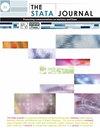Stata提示146:使用泊松回归模型后的余量来估计干预措施阻止的事件数量
IF 3.2
2区 数学
Q1 SOCIAL SCIENCES, MATHEMATICAL METHODS
引用次数: 1
摘要
在对泊松回归模型进行拟合以评估队列研究中干预措施的效果后,人们可能有兴趣估计干预措施阻止的事件数量(假设观察到的关联是因果关系)。这可以推导为干预组在反事实(无干预)和事实(干预)情景下预测的事件数量之间的差异。可以使用预测命令来获得两种情况下的预测事件数,然后总结差异,但由于几个原因,这种方法并不方便。需要更改干预变量以获得反事实预测值,并且置信区间不容易获得(可以使用bootstrap或jackknife,但如果数据集很大,这可能特别耗时)。我们建议使用margins命令。然而,对于我们的特定问题,它的使用并不是直接的——裕度计算观测值,然后这些本文章由计算机程序翻译,如有差异,请以英文原文为准。
Stata tip 146: Using margins after a Poisson regression model to estimate the number of events prevented by an intervention
After fitting a Poisson regression model to evaluate the effect of an intervention in a cohort study, one might be interested in estimating the number of events prevented by the intervention (assuming the observed associations are causal). This can be derived as the difference in the intervention group between the predicted number of events under the counterfactual (no intervention) and the factual (intervention) scenarios. One could use the predict command to obtain the predicted number of events under the two scenarios and then sum up the differences, but this approach would not be conve-nient for several reasons. One would need to change the intervention variable to get the counterfactual predicted values, and the confidence intervals would not be readily available ( bootstrap or jackknife could be used, but this could be particularly time consuming if the dataset is large). We here suggest the margins command. Its use, however, is not straight-forward for our specific problem margins computes observation then the these
求助全文
通过发布文献求助,成功后即可免费获取论文全文。
去求助
来源期刊

Stata Journal
数学-统计学与概率论
CiteScore
7.80
自引率
4.20%
发文量
44
审稿时长
>12 weeks
期刊介绍:
The Stata Journal is a quarterly publication containing articles about statistics, data analysis, teaching methods, and effective use of Stata''s language. The Stata Journal publishes reviewed papers together with shorter notes and comments, regular columns, book reviews, and other material of interest to researchers applying statistics in a variety of disciplines.
 求助内容:
求助内容: 应助结果提醒方式:
应助结果提醒方式:


